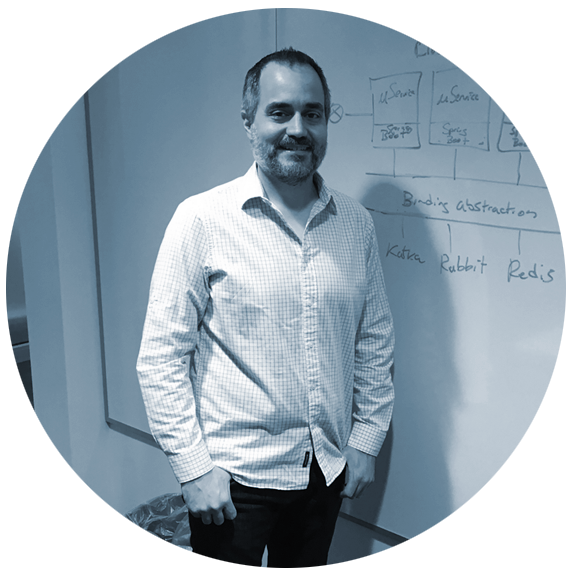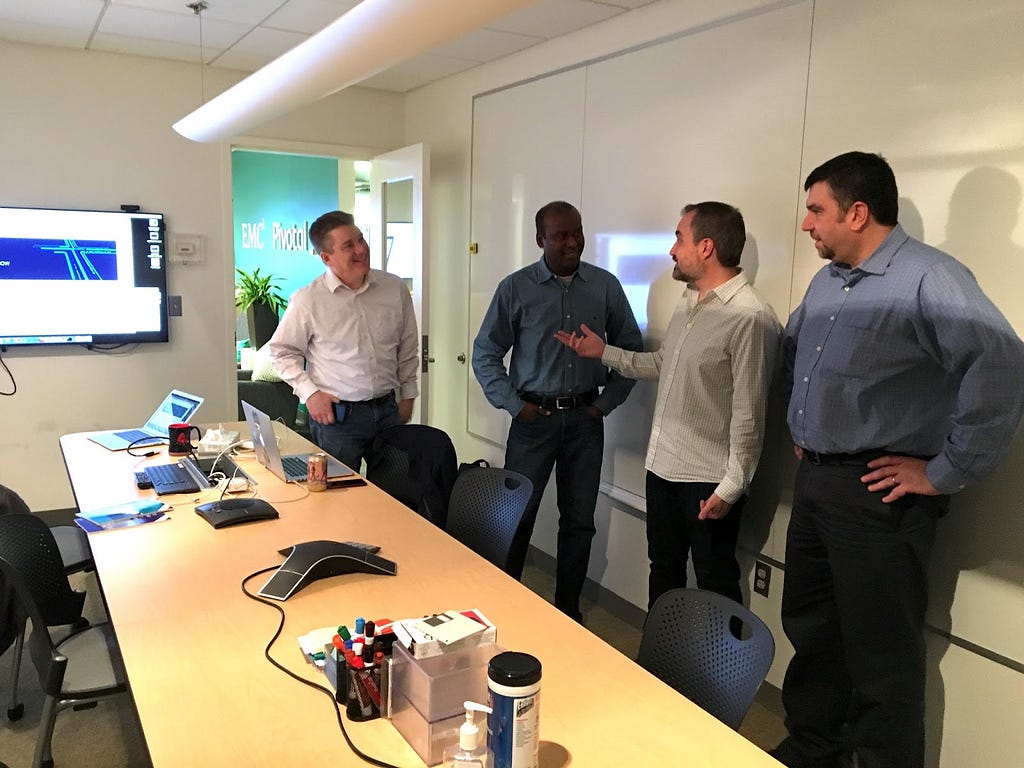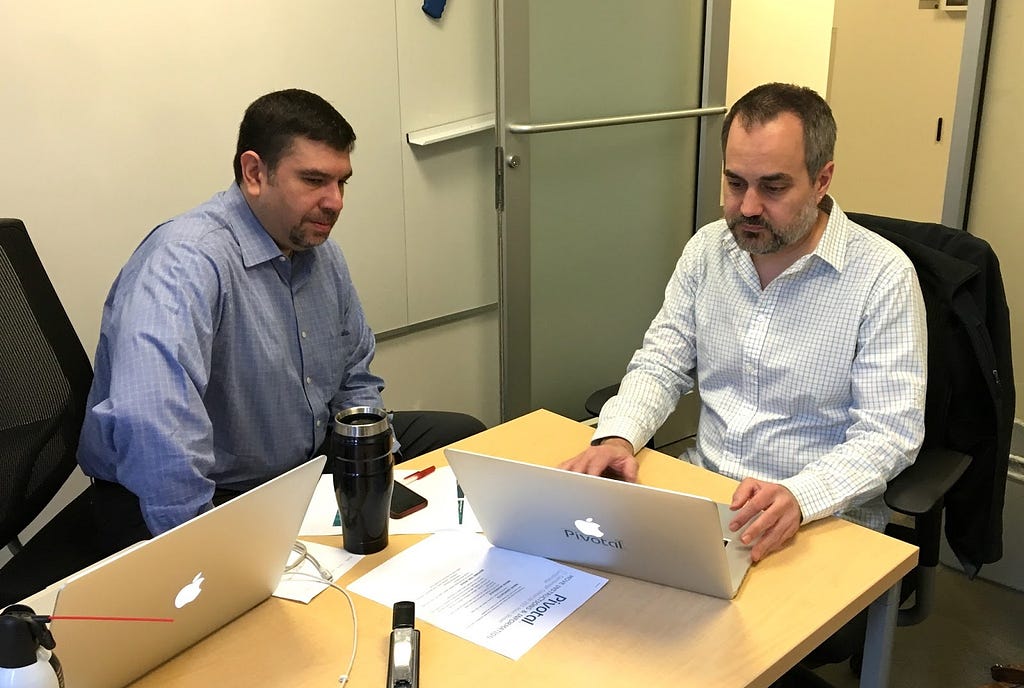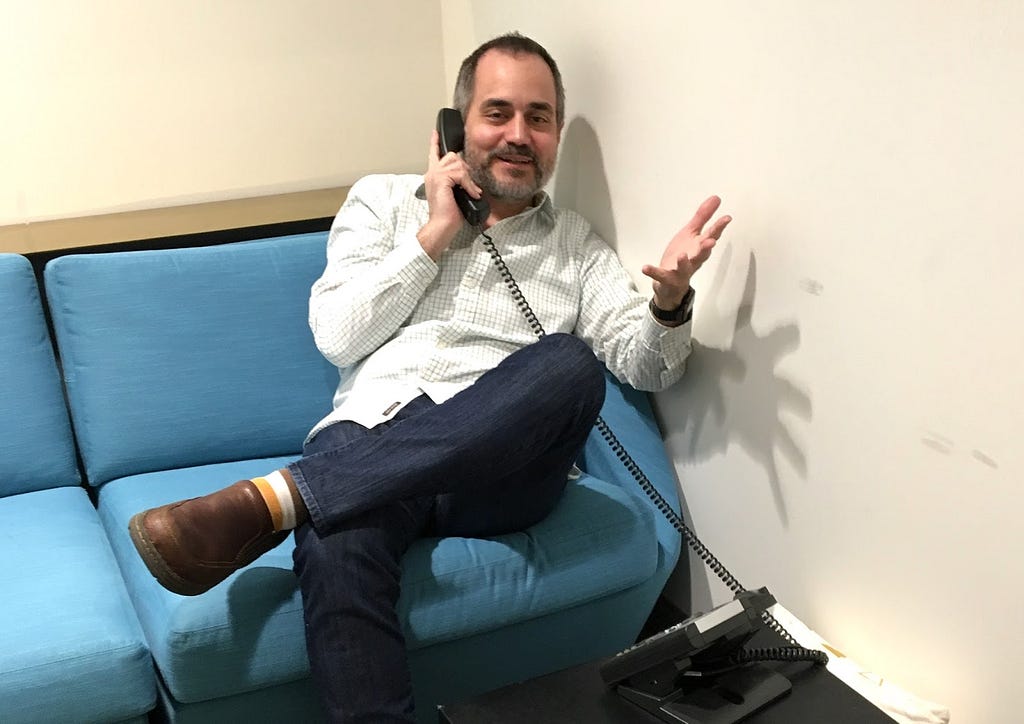Pivotal Platform Architect Chuck D’Antonio walks through a typical day
One of the best ways to get insight into what it’s like to work at Pivotal has been our Day in the Life series, which we’ve done for Product Managers, Designers, and Engineers. But today we’re going to feature another role, the Pivotal Platform Architect. A Pivotal Platform Architect helps companies learn how Pivotal Cloud Foundry, Pivotal Labs, and other Pivotal software can solve their IT and engineering challenges. Here’s what a typical day looks like for this role…

Chuck D’Antonio
PLATFORM ARCHITECT, PIVOTAL, BOSTON

I found Pivotal… when Pivotal found me on LinkedIn. I’d been familiar with Tracker and Cloud Foundry earlier in their lives, but didn’t have a lot of knowledge of what the company had become.
I decided to join Pivotal because… Pivotal’s approach spoke directly to the challenges I was having as an engineering manager trying to drive change in a large organization. I knew that my company wasn’t the only one struggling and knew that if Pivotal could help me, it could help a lot of others. I also thought I could help Pivotal because I had been the customer Pivotal targeted, and could empathize with the people we work with.
I am currently working on… building more and more momentum for Cloud-Native applications at our largest customer in New England, helping a new customer understand how working with Pivotal will change the way they deliver value to their customers, and a presentation about what Cloud-Native architectures mean for enterprise integration.
8:45 AM — Breakfast and Pivotal office standup

Pivotal brings in breakfast every morning. In addition to delicious food, it’s a great chance to hang out and catch up with coworkers.
I get in at different times depending on whether my kids are with me or not and if I’m heading to the office or to a customer. When they’re with me and I’m headed to the office, I get in around 8:30 AM and grab breakfast.
Our office caters breakfast every morning, and today I ate with one of our sales reps, Greg, talking about a few of his clients. Then we hung around for the office standup. We have an open office at Pivotal. Breakfast and office standup is a great time to connect with other Pivotal teams to learn about what everyone is working on. We work closely with Pivotal Labs on many engagements, and breakfast is a nice informal time to catch up, see how projects are going, and talk strategy with Labs Pivots about our clients.
9:10 AM — Check in with account rep

One of our account reps, Larissa, has been working with an existing enterprise client. A business unit we’ve been wanting to do more work with is interested in bringing a new product onto Pivotal Cloud Foundry. She had a quick meeting with their team at the end of last week, and has a high-level understanding of some of the problems their team is facing.
In this case, the team has some big challenges in their release process. They have multiple environments and a huge codebase that requires hours to build. Each change they make leads to major headaches merging and pushing down the pipeline toward production. On top of this, their process to release to their primary QA environment is completely different than their production release process. This is killing them, as issues are popping up in production pushes that they could have caught and solved higher up stream if the deployment processes were aligned.
Because we’ve worked with a lot of different teams at this customer before and have a pretty good understanding of their pain points, I’m recommending that we proceed with a workshop with the client and their key stakeholders.
In a workshop, we’ll dive in to Pivotal Cloud Foundry and demo how the platform can help solve the customer’s unique problem set. Their team will actually get some hands-on-keyboard experience with the software, and they will see the impact Pivotal Cloud Foundry, Concourse and Spring Cloud can have on standardizing the release process across environments.
10:30 AM — Team office hours

Once a week, we’ll get together as a team and have office hours. To kick off office hours, we do a Labs-style standup: we introduce any new faces, talk about any helps, interestings, and upcoming events.
From there we’ll usually jump into information share and storytelling. Are there any unique customer problems that have come up that the team would benefit hearing? If we all know the story, we can better help our clients in the future.
This week the Pivotal Cloud Foundry team has been developing some new features, and I’m excited to get an advanced sneak peek at the demos.
11:30 AM — Read the weekly status report

I carve out a quick bit of time to look over our project status report document, and update my items. This is a great way to stay informed on the activity on other accounts by other Platform Architects.
One of my colleagues, Mark, is on a client site working on a proof of concept (POC), so I’m particularly interested in reading how that project is going. We don’t do POCs that often, but it’s a pretty cool experience.
Mark has spent a lot of time over the last couple of weeks embedded with the client’s team to understand how Pivotal Cloud Foundry will work in their environment. Together with the client, they’ll install the platform, do initial provisioning and migrate some apps and services over. The client team is getting direct experience in Pivotal Cloud Foundry, but it’s important that we optimize for speed at this stage. This is definitely NOT production ready, by any means, we just want them to get their hands on our software within the context of their architure.
11:45 AM — Prep for afternoon deep dive

This afternoon I’m leading a technical deep dive with a potential new client.
Sean, another account rep, and I do some prep work to make sure we’re aligned on what we’d like to cover, who will be there, and plan logistics (travel, client’s office setup and whiteboard availability, etc.). I beat Sean in rock, paper, scissors, so I’m driving, but first — lunch!
1:30 PM — Technical deep dive

At a deep dive, I’ll lead a session to draw out the client’s pain points, and how Pivotal Cloud Foundry and Pivotal Labs can fit as solutions.
A technical deep dive lets us get into the details of the client’s current architecture and what integrations they have. This helps draw out where their pain points are, and how we can begin to craft solutions for this customer’s specific set of problems.
This client is really interested in microservices, so I spent some time talking about risks and opportunities of monolith applications vs. microservices. They’re also seeing a lot of integration challenges and looking at an enterprise service bus (ESB) as a solution, and I’m worried that if they go that way they’ll just swap one monolith for another. I’m glad I spent a few hours last week coding a demo with Spring Cloud Dataflow, because it helped explain how to handle integrations with data microservices.
Our goal coming out of the deep dive is to have a firm grasp on the problems the client is facing, and begin forming solutions and recommendations.
4:00 PM — Heading back to the office
Today’s session went pretty well. The clients had a lot of questions, and were eager to go even deeper and get some hands-on-keyboard experience. Since we drove out together, Sean and I will debrief on the way back to the office and discuss next steps.
4:45 PM — Check back in with Larissa

I usually know Larissa is in the car on the way back from client meetings when I see her number pop up on my phone.
She caught up with the client earlier in the day and it sounds like they are really excited to go forward with the workshop. They have some key stakeholders already in town and wanted to know if we could come back this week for the workshop!
5:15 PM — Workshop prep
While this is fresh in my mind, I’m reviewing some notes from our active engagements. With information from Larissa about this new unit, we’ll be able to put together an agenda that will be most valuable to the client.
Larissa will help coordinate getting the right people in the room. Key attendees that I hope can attend are representatives from enterprise architecture, engineering and operations.
5:30 PM — Check in with my manager
Today was busy, so I want to catch up with my manager, John, to fill him in. John is often juggling the team allocations, with a goal of maintaining the relationships we have with our clients but also making sure the team’s bandwidth is sustainable.
6:00 PM — Head out for the day
It’s been a busy day, and it’s just about time to call it. Sometimes I’ll grab a beer (our office is fully stocked!) but today I’ve got the kids so I’m going to head home and get started on dinner. I love to cook from scratch and I find some alone time chopping vegetables is a great way to recharge after a day full of great conversations.
Pivotal is currently hiring for Platform Architects and other roles across all our offices. If you’d like to learn more, please visit our careers page.
This profile of Chuck D'Antonio was written by Chris Sesno.

Change is the only constant, so individuals, institutions, and businesses must be Built to Adapt. At Pivotal, we believe change should be expected, embraced and incorporated continuously through development and innovation, because good software is never finished.

A Day in the Life of a Pivotal Platform Architect was originally published in Built to Adapt on Medium, where people are continuing the conversation by highlighting and responding to this story.























